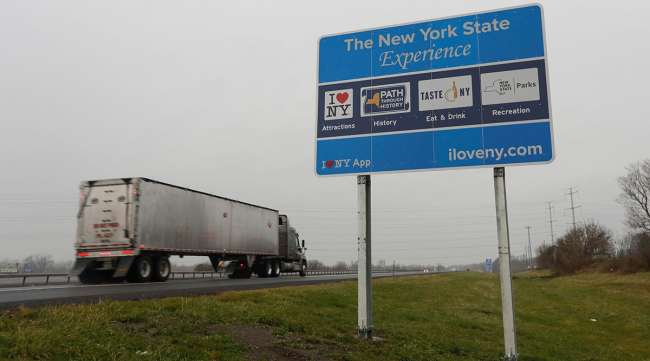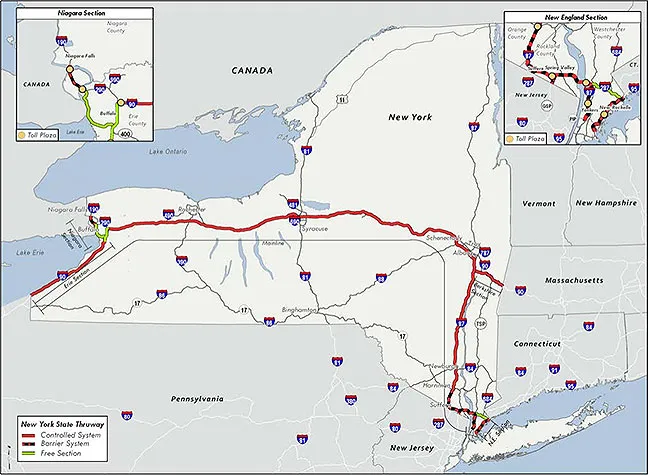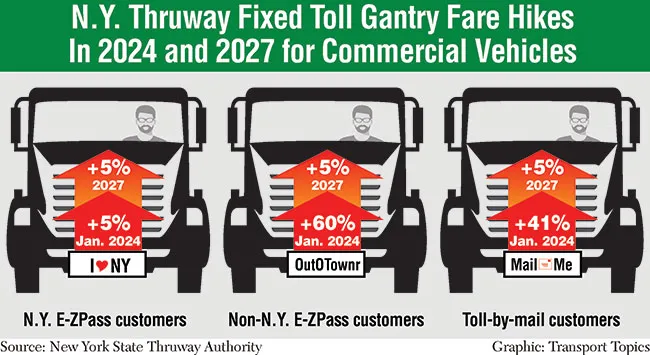Staff Reporter
Truckers to See Higher Tolls on New York Thruway in January

[Stay on top of transportation news: Get TTNews in your inbox.]
For the first time in 14 years, travelers will pay more on the New York State Thruway system starting in January followed by another rate hike in 2027 due to revenue needs for aging infrastructure.
The two-phase rate increase was recently approved by the New York State Thruway Authority, which relies on revenue from user fees since the roadway receives no dedicated federal, state or local tax dollars.
“The toll adjustments approved today by the Board of Directors follow a yearlong public process and represent a responsible approach to ensure continued investment in the 570-mile Thruway system for years to come,” said Joanne Mahoney, board chair.
Thruway officials said there was a $470 million shortfall in the budget to pay for needed capital projects in the existing 2022-2026 Capital Program. The 2023 budget invests a total of $413 million to support its capital program, which is scheduled to invest $1.9 billion into projects through 2027.
The thruway was built in the 1950s. About 85% of its roadway base, which dates to the original construction, needs heavy maintenance, reconstruction and updating to have a riding surface maintained in good condition.
Another concern arises from the thruway’s 815 bridges. While the average age of the bridges is 55 years old, 75% are more than 60 years old.
Inspections indicate that more than 85 bridges must be replaced within the next 10 years at a cost today of $800 million.
“The need to replace bridges grows exponentially after the 10-year timeline when hundreds of bridges will need to be replaced in the following decade,” according to the Thruway Authority. “Factoring the hundreds of bridges that will require replacement not long thereafter, the costs escalate into the $6-$7 billion range.”

New York Thruway Authority
Frank Hoare, acting executive director, said the new toll fees will ensure the thruway meets its systemwide operating, debt service and capital needs in the financial plan while offering among the nation’s lowest toll rates.
To illustrate how low its fares are compared with other toll roads, the Thruway Authority said the highway’s base passenger vehicle toll rate is less than 5 cents per mile, while the Ohio Turnpike charges 6 cents per mile, the New Jersey Turnpike is 11 cents and 31 cents a mile, and the Pennsylvania Turnpike’s rate is 14 cents per mile.
Hoare said, “This proposal was developed to ensure the safety and reliability of the thruway by providing the Authority with additional revenue to meet our infrastructure and operational needs.”

Gragg Wilson of UPS won grand champion honors at the National Truck Driving Championships. Wilson takes us through the competition's course, successful driving practices and how to attract new drivers. Tune in above or by going to RoadSigns.ttnews.com.
The largest contributors to the thruway’s 2022 operating revenue of $488 million were passenger vehicle tolls (47.6%) followed by commercial vehicle tolls (42.9%) and tolls paid by mail (5.5%).
Thruway tolls are primarily split into three categories: N.Y. E-ZPass customers (who pay the lowest rates), non-N.Y. E-ZPass customers (who pay more and 15% higher for commercial vehicles) and tolls paid by mail customers. The latter is the highest rate because it is more labor intensive.
Within these three rate categories, commercial vehicles can fall within six different classifications based on their number of axles. The lowest is for two axles and the highest is for seven or more axles.
Starting Jan. 1, the base N.Y. E-ZPass rate will increase by 5% outside the Gov. Mario M. Cuomo Bridge in the first toll hike for those customers since 2010. A second 5% increase will take effect in January 2027. Standard toll rates for non-N.Y. E-ZPass customers (currently 5.1 cents per mile for passenger cars) and mail customers (currently 5.8 cents per mile for passenger cars) both will increase to 8.6 cents per mile in 2027.
Given all the variations in new toll rates for trucking, a clear picture of the impact of the new fees can be seen in looking at future mainline per-mile rates for fixed toll gantry fares for commercial vehicles. In January, these rates will be 5% higher for N.Y. E-ZPass drivers, up 60% for non-N.Y. E-ZPass drivers and raised 41% for tolls paid by mail. All these fares will climb by 5% in 2027.

The fixed rate toll for the Gov. Mario M. Cuomo Bridge for N.Y. E-ZPass customers will increase by 50 cents each year through 2027. In 2027, the base N.Y. E-ZPass rate for passenger vehicles will be $7.75, with commercial toll rate increases to be proportionate with passenger rate increases.
The board’s decision to hike its toll rates came after a lengthy public process that started in December and included five public hearings this year in which 210 public comments were evaluated.
“We’d like to thank individuals and industry representatives who attended the public hearings, those who contacted us expressing their opinion on the proposal, and elected officials for their feedback,” Hoare said.
Thruway officials received comments objecting to the toll increases because higher rates could cause some drivers to take other routes and traffic could spill onto other roadways. “In most cases, traffic diversions are expected to divert to state highways and other major arterials, not to local roads,” noted a report on public commentary, adding that the “proposed toll modification would not result in significant adverse effects related to traffic diversions.”
Representatives of smaller owner-operator truckers said higher tolls would hurt their bottom lines.
Want more news? Listen to today's daily briefing below or go here for more info:




